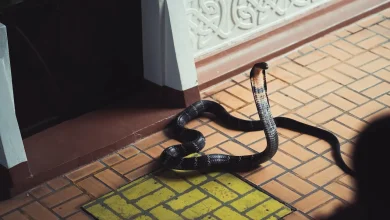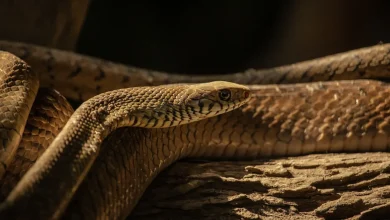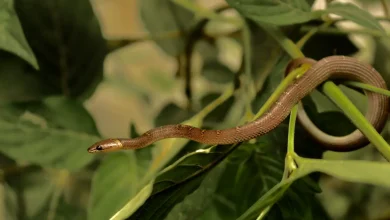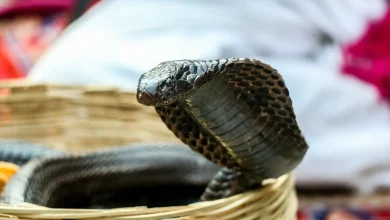King Cobra Hatchlings
Baby King Cobra Hatchlings
The King Cobra, a majestic and formidable reptile, exhibits a fascinating and unique reproductive process, from mating rituals to the hatching of their young.
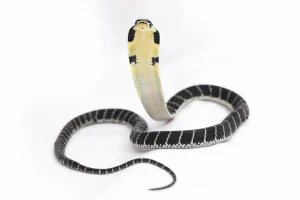
The Life Cycle of the King Cobra: From Mating to Hatching
Mating Rituals of the King Cobra
The mating season for King Cobras begins in January, when males set out in search of receptive females. Upon finding a suitable mate, the male engages in a unique mating ritual by intertwining his tail with the female’s and using one of his two hemipenes to transfer sperm into her cloaca. This fertilization process can occur shortly afterward, although females have the ability to store sperm for extended periods.
Mating among King Cobras carries inherent risks, including instances of cannibalism observed by scientists and zookeepers. This mating process typically extends until April, and it’s not uncommon for King Cobras to mate with the same partners in successive years.
Nest Building and Egg Incubation
Following successful mating, the female King Cobra embarks on the construction of a nest using an array of materials such as vegetation and sticks. Once the nest is ready, she lays between 20 to 40 eggs inside it. Remarkably, female King Cobras exhibit maternal instincts by vigilantly guarding their nests. In some cases, males may also remain nearby. During this period, King Cobras, normally reclusive, display heightened aggression, particularly when defending their nests, leading to most human bites.
King Cobras hold the unique distinction among snakes for not only building nests but also actively guarding their eggs. There is speculation, though not scientifically confirmed, that the heat generated from the decaying vegetation in the nest aids in the incubation of the eggs.
This intricate and carefully orchestrated life cycle of the King Cobra, from mating to hatching, highlights the complexity and adaptability of these majestic creatures. Their behavior underscores the depth of their parental investment, a trait relatively rare among snake species.
Hatching of the King Cobra
The hatching of King Cobras coincides with the monsoon season, typically in late summer or early fall. The early life stages of these serpents are shrouded in mystery, as scientists continue to unravel the complexities of their juvenile behavior. Young King Cobras are known to feed on snakes and lizards, similar to adult diets, but they exhibit a preference for arboreal hunting. Their appearance is distinct from adult cobras, featuring a glossy black hue adorned with yellow or white bands.
Maturation of King Cobras
In the wild, King Cobras usually reach maturity within five to six years, although this can be delayed in regions with scarce food resources. In contrast, those raised in captivity with ample food supply can grow rapidly, reaching lengths of up to 6 feet in their first year. Adult King Cobras typically measure between 9 to 16 feet, with females often outgrowing males.
King Cobras are known for their longevity, especially in controlled environments like zoos, where they can live for over two decades. This extended lifespan is a testament to the resilience and adaptability of this revered snake species.
The life cycle of the King Cobra, from its unique hatching process to its impressive growth into a mature snake, is a testament to the intricate and fascinating world of reptiles. Their development stages highlight not only their survival instincts but also the delicate balance they maintain within their ecosystems.
Juvenile, found in Southern Thailand
I was hoping this year was going to be THE YEAR I found a king cobra hatchling – at least one under a meter. Alex Gillard made it happen for me, I didn’t get to find it, but we were at the same place and I’d actually just passed the place he found the little king – about 30 minutes before. Good enough for me, I just wanted to see one in the wild and get some photos and videos.
This has been my target species for about ten years now. I’ve found some adults, and one adult even found me, but I have never seen a king cobra in the wild less than three meters in length.
Juvenile king cobras are very difficult to find. People say they’re ‘smart’ – and yeah, I guess they are. I’ve never even heard of someone finding a hatchling king in the wild. One time a doctor from Malaysia sent me a photo of a tiny hatchling outside his clinic – in the middle of the day. It had probably just hatched.
Certainly, nobody goes looking for and finds king neonates.
Until Alex found one.
So, anyway. My life is complete. Enjoy the photos of this stunning little one-month old king cobra found in Krabi. I don’t know how many times I’ve been herping over the last ten years, certainly well over 1,000 times. And still, I’ve never found one myself!
Anyway, yeah, enjoy…


